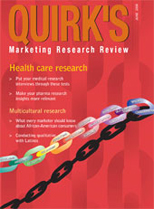Editor’s note: Gavin Johnston is vice president of research and strategy at Two West Branding and Communications, Kansas City, Mo.
In general, companies hire ethnographers (anthropologists, sociologists, etc.) for a simple reason: to uncover new ways to achieve competitive advantage and make more money. This translates, most often, into research to understand new product opportunities or develop brand positionings or salient marketing messages.
Unfortunately, as researchers and ethnographers, we find that our clients often have no idea what to do with the research information we provide them. The fault lies with us, not the client, and can be overcome if we apply ourselves just a bit.
When clients complain about the research experience they typically fall into two broad camps. When you hear the phrases “It’s too academic” or “I don’t know what to do with it,” the right thing to do is tell the client you will revisit the research and translate it into something they can use. Better still, make sure they never feel that way. Not only does this save the researcher countless hours of added work, but more importantly it helps ensure a returning client who sees the value of well-done ethnography and advocates for its use.
The heart of the matter
So what does it mean when a client says, “It’s too academic.”? It means that they didn’t hire you to teach a class about anthropological theory and method. It means that they need more than interesting bits of human behavior. It means they don’t want to sit through a 100-page PowerPoint presentation before getting to the heart of the matter. They are in business and have neither the time nor the interest of a scholar or student. Of course, this doesn’t mean that you don’t do the work or that you fail to set up the points you are trying to make, but it does mean that you be cognizant of the fact that the audience hired you to improve their business and products, not teach a course on anthropological methods.
And to be fair, meetings are a constant (often annoying) reality for executives. They have little or no time to waste. The people with the luxury of sitting through a lengthy presentation rarely have a significant amount of authority in the decision-making process, and they rarely hold the purse strings. This isn’t to say that those two hours of research findings we put forward aren’t meaningful, but rather that presentations need to be tailored to the needs of the people buying your product. For the business community, the product is knowledge and the ability to make that knowledge useful.
Solution is simple
The solution is simple and deceptively obvious: Tell them what you are going to tell them, tell it to them, then tell them what to do with it (this final point can’t be stressed enough). A corporate presentation or report is not a textbook or an artfully-crafted novel and the people buying your services aren’t generally interested in a stunning climax at the end. You can and should still tell a story, but the story needs to be simple and direct – an abridged version, so to speak.
Start by quickly and succinctly telling them why they are there, why it matters and what the main points are on which they need to focus. The people you need to influence will stick around and pay attention to what you tell them if your presentation begins, for example, by telling the client, “You have thought people liked the taste of your beer. But the truth is they drink it because it tastes funky and that gives them street credibility.” Spending 15 minutes explaining the concepts of social capital and dramaturgy will simply put them to sleep.
Act upon
The other frequently-heard phrase after presenting research findings to a client is “I don’t know what to do with it.” It isn’t enough to encapsulate your work into a form that can be quickly grasped; it needs to be something they can act upon. Video footage of a woman demonstrating how to buy Valium from India online may be interesting but that doesn’t mean the client knows why it is significant or how to use the information. People need very concrete bridges between findings, insights and application, and the information you put out there is of little strategic or tactical value if you can’t apply it.
The value for clients in hiring anthropologists and ethnographers goes beyond the cultural lens we use to look at the world. The value lies also in the holistic view of the world we are trained to take in and the way we connect seemingly unrelated (or seemingly unimportant) information into innovative approaches to a business problem. Our seemingly-skewed way of “reading” the world is unique and results in unique solutions that we must articulate.
Something actionable
When all is said and done, ethnography is an incredibly powerful tool, but only if it can be turned into something useful for the client. The job doesn’t end when you’re finished collecting data. It doesn’t even end with analyzing and interpreting that data. It ends when the information you have collected can be turned into something actionable by the client, be it a new ad campaign, a new brand platform or a new type of hammer.
The researcher, research team, creative team, client and everyone invested in the project need to work toward turning information into a final product. When the time comes to sit down with the client and explain what you saw, heard and did, the ethnographer better be prepared to also explain what to do with it next. If we keep that in mind as we work through the data, our value to our clients will be unparalleled.
